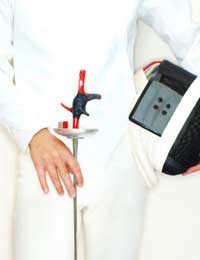Staying Safe When Fencing

Crossing swords with an opponent is one of the oldest forms of competition, requiring speed, agility and no little amount of bravery. It is also a very physical game of chess, testing the mettle of the other competitor, and building a strategy upon which the coup de grace can be delivered.
However, in common with all sporting contests, there is an ever-present risk of injury, which is why there is a strict code of practice in force to ensure that a bruised ego is the most that the loser is left nursing.
Safety starts with the referee of the contest, who must not only ensure that all the equipment is up to standard but also that in the heat of the battle, both sides remember that this is purely a friendly encounter. This is not to say that each fencer should not be enthusiastic in their approach, but the aggression must be controlled – loss of temper not only places a competitor at risk of losing focus and losing the match, but they may end up doing damage to themselves or their opponent.
Jackets and breeches must be correctly fitted
Safety checks should begin with the clothing of each fencer: jackets and breeches must be correctly fitted and without any tears, and the latter should be long enough to cover the top of the socks. Underneath the jacket, a quilted pad known as a plastron is also required, in order to protect the chest, waist and sides. Female contestants must also wear breast protectors. The gauntlets must extend over the sleeves of the jacket and up to around half the length of the forearm.
Because of the cut and thrust of the battle, it is essential that the fencer’s footwear has a good grip, in order to prevent any slips that could result in injury.
Another important area is the head, which is protected by the most visible piece of safety equipment in the fencer’s locker: the mask. Suitable headgear must conform to a manufacturer’s safety standard, and the mesh that covers the face must be checked in order to ensure that there are no tears.Check to ensure the blade is not damaged
In terms of the weapon itself, it is always subject to a rigorous check to ensure that the blade is not damaged, as this is the most common reason why injuries occur. The guard of the weapon is another area that should be scrutinised as any sharp edges can lead to injuries to an opponent’s lower body during the contest.
Young children are often taught the basics using foam weapons but even these relatively safe implements come with a requirement to wear a plastic facemask.
Ultimately, safety is all about commonsense, as the above guidelines illustrate. As long as every competitor has a respect for these rules, along with an equal respect for their opponent, then there is no reason why a fencing contest cannot be conducted without the risk of injury. Everyone wants a good, clean, competitive battle that lives up to the traditions of this historic sport.
Each fencer has a responsibility to uphold these traditions.
- How People With Epilepsy Can Enjoy Sport
- Ten of the World's Most Dangerous Sports
- Seated Exercise for the Elderly
- Boxing Dangers & Safety Precautions
- Children and Sport - When to Begin
- Safe Exercise With Diabetes
- Wrestling Safety
- Trampolining Safety
- Safe Sports For Kids
- Safe Exercise for the Elderly
- Safe Exercise During Pregnancy
- Safe Exercise with Heart Problems


Re: Gym Induction: What to Expect
SUIIIIIIIIIIIIIIIIIIIIIIIIIIIIIIIIIIIIIIIIIIIIIIIIIIIIIIIIIIIIIIIIIIIIIIIIIIIIIIIIIIIIIIIIIIIIIIIIIIIIIIIIIIIIIIIIIIIIIIIIIIIIIIII…
Re: Bungee Jumping Safety
Hi, i want to know about bungee jump training time and training cost and where about
Re: Badminton Safety
1. What are some of the injuries that might result in playing badminton? 2. What is one method you can do/use to avoid injuries? Warm Up / Warm…
Re: Badminton Safety
1. What are some of the injuries that might result in playing badminton? 2. What is one method you can do/use to avoid injuries? Warm Up / Warm…
Re: Badminton Safety
1. What are some of the injuries that might result in playing badminton? 2. What is one method you can do/use to avoid injuries? Warm Up / Warm…
Re: Badminton Safety
1. eye injuries, Tennis elbow, knee injuries, Ankle injuries. 2. It can be avoided by proper preparation like lack of technique, lack of…
Re: Badminton Safety
1. What are some of the injuries that might result in playing badminton? The person most at risk is the player who is nearest the net when their…
Re: Benefits of Joining an Athletics Club
Hi i m yassir i have 1500m 3:54 and 800m 1:55 and 3000m 8:36
Re: Table Tennis
im a big fan of ping pong (table tennis)
Re: Using The Gym Safely: Equipment
I am looking for signage to put up on the use of gym equipment for the gym we have built as part of our property…